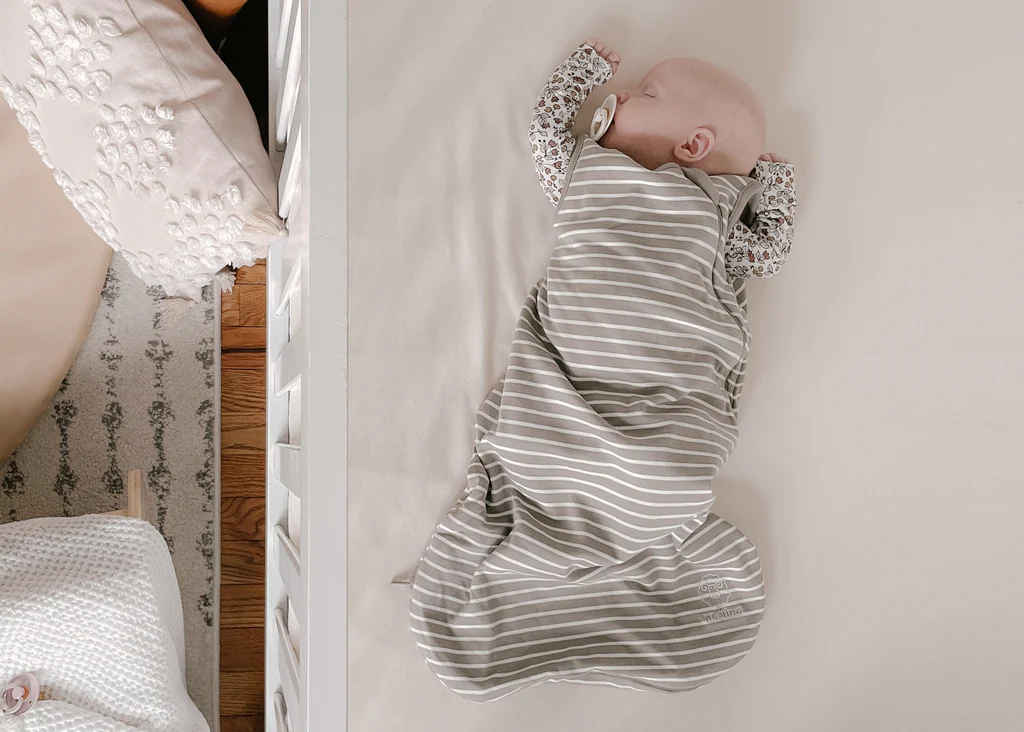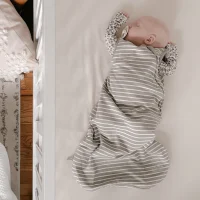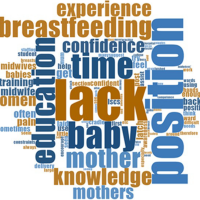Swaddling—the practice of snugly wrapping an infant in a lightweight blanket—can help reduce the startle reflex, mimic the snug environment of the womb, and soothe babies experiencing sensory overload.
To identify top-performing swaddles, we collaborated with five families who trialed 11 different swaddle designs over two weeks using babies aged 2 to 12 weeks. Additionally, insights were gathered from four childbirth and postpartum specialists. While no single swaddle suits every baby, and preferences may shift as a child grows from the newborn phase to older months, our evaluation revealed the Happiest Baby Sleepea as a standout choice. It consistently maintained a secure wrap, proved user-friendly for caregivers, and prioritized both safety and comfort for infants.
Who this is for
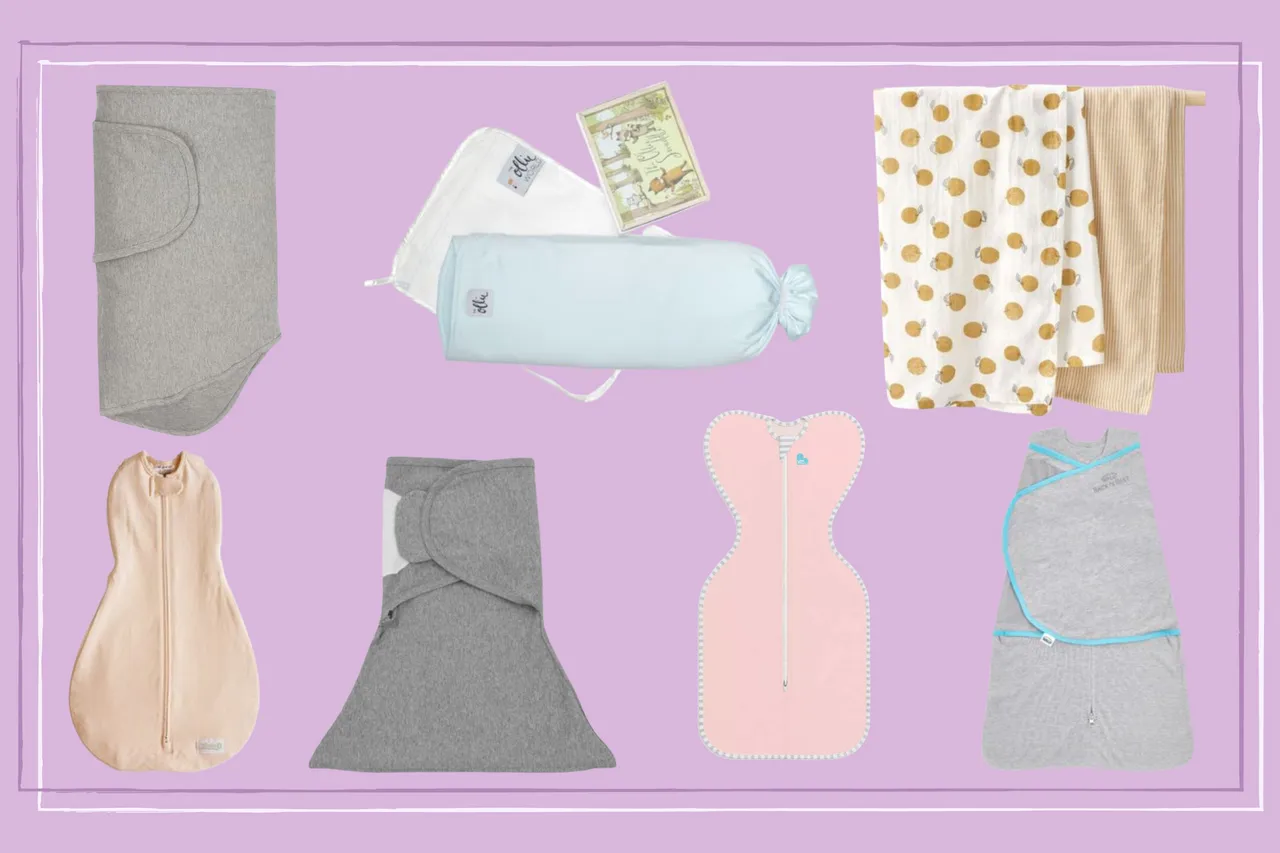
The first weeks after birth are crucial for infants, as they adapt to the sensory-rich world beyond the womb—a transition often referred to as the “fourth trimester.” During this period, creating a womb-like environment helps soothe newborns and supports their adjustment. “Developmental needs differ significantly between newborns (0–3 months) and older infants,” notes Rebecca Mercer, a postpartum doula and infant care specialist. “Swaddling—snugly wrapping a baby in a blanket to restrict movement—mimics the confined, comforting space of the uterus, reducing startling reflexes and sensory overload.” Research from Seattle Children’s Hospital underscores this, highlighting swaddling as a top method to calm fussy infants and prevent sleep disruptions caused by involuntary movements.
Safety guidelines emphasize vigilance as babies grow. Once an infant shows signs of rolling over (typically between 4–6 months), swaddling becomes hazardous due to suffocation and Sudden Infant Death Syndrome (SIDS) risks. The American Academy of Pediatrics (AAP) advises discontinuing swaddling at the earliest sign of rolling attempts, which can occur as early as 2 months. Transitioning to arm-free swaddles or sleep sacks is recommended for older infants who still benefit from light containment. Individual preferences vary: some babies resist swaddling from birth, while others outgrow it by 3–5 months. Mercer observes, “Each child responds uniquely—swaddling works best as a flexible tool, not a one-size-fits-all solution.”
Key safety practices include avoiding loose bedding, ensuring proper hip alignment by leaving leg room, and monitoring for overheating. While swaddling aids sleep consolidation, caregivers should prioritize back-sleeping positions and discontinue the practice once mobility develops.
Our pick: Happiest Baby Sleepea
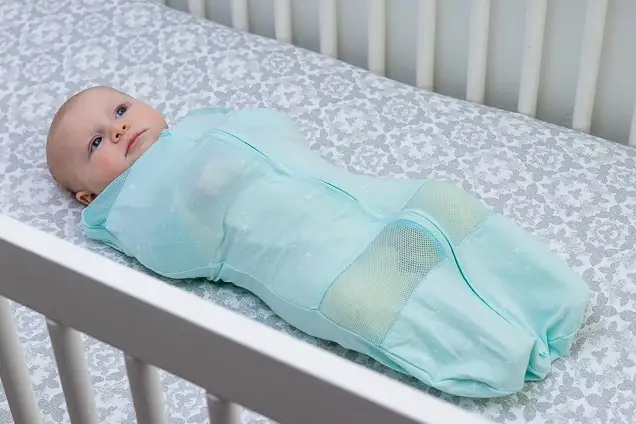
Developed by pediatric sleep specialist Dr. Harvey Karp, the Sleepea swaddle is an all-cotton adaptation of the sleep sack featured in his premium Snoo bassinet. It aims to resolve frequent concerns with traditional swaddles, such as babies easily escaping, overheating, excessive hip tightness, disruptive Velcro noise, and loose fabric near the face. Its design incorporates a distinctive interior panel for snug arm containment paired with an exterior zippered pouch, combining security and comfort. (For a detailed analysis of the Snoo bassinet, refer to our review: Is the $1,700 Snoo Smart Sleeper Bassinet Worth It? What to Know Before You Buy.)
While no swaddle can fully prevent a determined baby from wriggling free, the Sleepea’s escape-resistant construction outperforms many competitors. The interior Velcro panel adds a layer of security—even if a baby breaks free from it, their arms remain safely enclosed within the zippered outer layer. This dual-layer approach minimizes loose fabric risks, enhancing safety. The interior panel employs a “quiet Velcro” strip, which, while not silent, generates less noise than traditional Velcro used in other swaddles. Additionally, the reduced Velcro on the interior wings ensures softer, more flexible material, prioritizing infant comfort without compromising functionality.
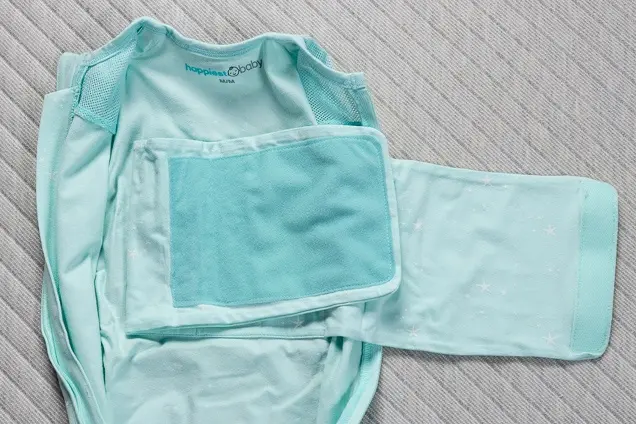
A parent in our testing group with a 6-week-old praised the Sleepea Swaddle’s intuitive design, sharing that when the Velcro was properly secured, her son “instantly settled, couldn’t escape, and slept comfortably.” She noted his nighttime sleep stretches extended to five hours—a marked improvement from his previous patterns.
Crafted from 95% organic cotton, 5% spandex, and breathable polyester mesh, the Sleepea stands out for its soft, lightweight feel. It provides gentle compression without restricting movement, striking a balance between the moderate support of the Halo (our second-place pick) and the firmer hold of the Woombie Air. Its design prioritizes healthy hip development with a spacious leg area and incorporates two strategically placed mesh panels—one near the shoulders and another around the knees—to enhance airflow. This addresses a common parental worry about overheating during swaddling. Among tested swaddles, only the Sleepea and Woombie Air included mesh ventilation, but the Sleepea’s dual-panel approach offers more comprehensive temperature regulation.
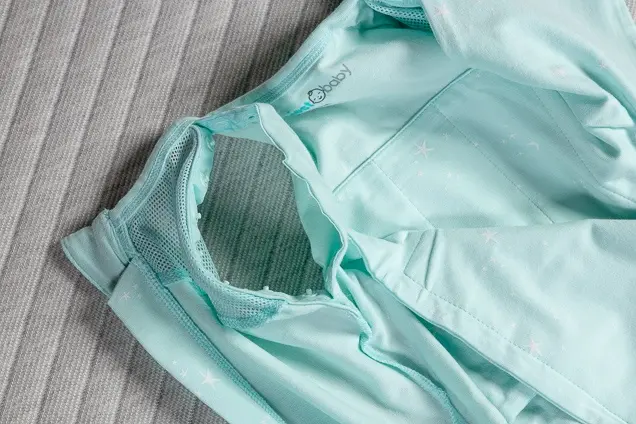
The Sleepea’s adaptable design supports a baby’s developmental stages. Its interior panel can be removed or adjusted around the torso while maintaining comfort, making it ideal for infants who crave the snugness of swaddling but desire more arm mobility within the sack. This flexibility mirrors the functionality of our other recommended option, the Woombie. For older babies transitioning out of full swaddling, the medium and large sizes feature shoulder snaps that can be unfastened to create armholes (akin to those on the Halo, our second-place choice). This allows caregivers to free one or both arms, gradually easing the shift away from swaddling as mobility increases.
Many users, including those in our test group, reported improved sleep patterns with this swaddle. “It’s the most effective swaddle we’ve tried,” shared one parent of an 8-week-old, noting seven-hour nighttime sleep stretches. Others praised thoughtful details: a reviewer appreciated how it “keeps arms securely positioned” and highlighted the convenient two-way zipper for nighttime diaper changes. Fathercraft’s assessment echoed these sentiments, stating, “The smart band and zippered closure create a Goldilocks fit—snug without being restrictive—outperforming other sleep sacks we’ve tested.”
Flaws but not dealbreakers
The Sleepea’s advertised “5-second swaddle” claim holds true primarily under ideal circumstances—when a calm or sleeping baby is placed inside without resistance. In real-world scenarios with active infants, securing the swaddle typically takes closer to 15 seconds, though caregivers still find it straightforward to use.
Its two-way zipper, a standard feature for diaper access, allows unzipping from either end. However, the sack’s narrow design complicates this process. One tester noted needing to tug excessively on their baby’s legs during bottom-up unzipping, ultimately preferring full top-down access. A redeeming feature: the interior panel remains fastened during changes, eliminating the need to fully unwrap the baby—a hassle with other swaddle designs.
The convertible shoulder snaps, designed for phased swaddle transitions, enable one- or both-arm freedom. Yet exposed snap studs lack coverage, potentially irritating sensitive skin. While this adaptability supports developmental milestones, the design oversight may affect comfort for some infants.
Care instructions require attention—Velcro straps must be fastened before washing to prevent snagging on mesh panels or other laundry items. Neglecting this step risks fabric damage over time.
Sizing proves critical with the Sleepea. Multiple Amazon reviewers caution it runs short, advising prioritizing length over weight guidelines. Smaller babies may experience loose arm panels despite tight adjustments, as one user observed: “Even at maximum tightness, the Velcro straps don’t secure arms adequately.” Another noted occasional neck fabric bunching, a common issue with peanut-shaped swaddles lacking exterior wings. Some parents mitigate this by leaving the top zipper slightly undone, maintaining both safety and comfort.
Runner-up: Halo SleepSack Swaddle
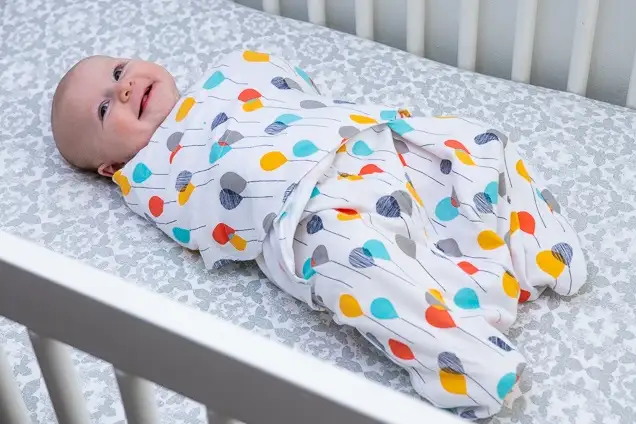
The Halo SleepSack Swaddle—a wearable blanket featuring swaddling wings—offers a cozy yet less restrictive fit compared to form-fitting alternatives. Made with all-cotton material (available in organic cotton for newborns and microfiber versions), it generally retains less heat than the cotton-spandex blend used in products like the Woombie Air, though its lack of ventilation mesh and additional fabric layers may reduce breathability. Similar to the Sleepea, it includes a two-way zipper for convenience, but its more spacious leg area simplifies nighttime diaper changes. The Halo’s extended length compared to equivalent-sized Sleepea models accommodates taller babies and allows longer use for arms-out swaddling as infants grow.
The Halo SleepSack Swaddle earns praise from numerous Amazon reviewers for its oversized Velcro wings, which many parents find ideal for snugly securing a baby’s arms and torso, fostering a sense of security. Its 100% cotton construction—breathable yet warm—is frequently highlighted as a strength, with one reviewer noting its versatility for layering in cooler weather.
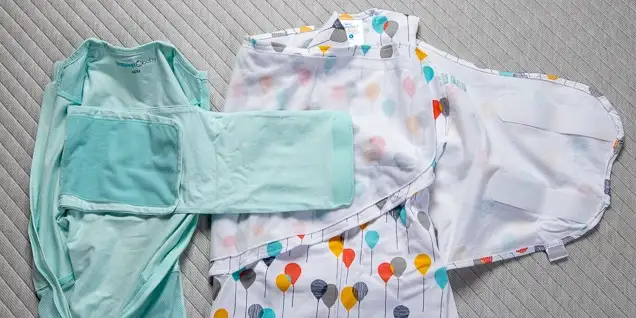
However, the design draws criticism for its broad Velcro panel, described by some caregivers and experts as overly restrictive or reminiscent of a straitjacket. The Velcro’s audible rip during adjustments risks disturbing light-sleeping infants, a drawback compared to quieter alternatives like the Sleepea. While some parents appreciate the exterior wings for enabling a natural swaddling position (hands near the chest) and supporting self-soothing behaviors, others report issues with babies escaping the wrap.

Unique armholes extend the swaddle’s usability, allowing older infants to transition to arms-out configurations while maintaining midsection snugness. A hospital nurse and parent attests to its durability through repeated washes. Yet sizing challenges arise: improper fit or loose wrapping can cause the fabric to ride up toward the face—a concern flagged by multiple reviewers. Halo advises ensuring proper sizing, tightening the wings, or switching to arms-out positions if this occurs. As with Velcro-based swaddles, securing the fasteners before laundering prevents snagging and prolongs the product’s lifespan.
Best for those who don’t want Velcro: Woombie Air

The Woombie Air offers a balanced solution for infants needing gentle containment while retaining some mobility. Its peanut-shaped design envelops babies from neck to feet in a streamlined pouch, using stretchy cotton-spandex fabric to provide subtle compression that minimizes startle reflexes—though less effectively than the adjustable wings of the Sleepea or Halo. While sizing determines the snugness (unlike customizable alternatives), its form-fitting structure allows more limb movement than other swaddles. The single-zip closure simplifies dressing, making it the most user-friendly option for quick transitions. However, its tailored fit necessitates nearly full removal during diaper changes, a trade-off for its minimalist, compression-focused design.
Parent testers observed the Woombie Air’s unique ability to replicate uterine-like comfort. One noted their 11-week-old slept soundly while maintaining a preferred hand-clasped position, stating, “My son instinctively brings his hands together in this swaddle—it mimics the womb’s coziness better than others we’ve tried”. To combat overheating concerns in its cotton-spandex blend, the brand incorporated breathable mesh inserts on the front. While this enhances airflow compared to earlier models, testers noted it still underperforms against competitors like the Sleepea, which features more extensive mesh ventilation.

The neckline’s snug fit drew mixed reactions. Designed to prevent fabric migration over the face during movement (a safety priority given the absence of arm-restricting wings), some caregivers expressed concern about potential discomfort, particularly for larger infants. Others observed occasional shoulder fabric bunching as babies shifted positions.
Amazon reviewers highlighted niche advantages. Parents of slender babies praised its tailored fit, with one sharing, “The Halo swaddled too loosely, but the Woombie Air’s snugness gave my daughter uninterrupted sleep”. Multiple users endorsed it as an ideal alternative to Velcro-dependent swaddles, especially for infants who self-soothe by keeping hands near their faces—a design feature aligning with natural newborn reflexes.
The competition
The Ergobaby Original Swaddler introduces design innovations like an ergonomic hip alignment insert—a fabric panel inside the leg area—but testers found it initially perplexing. A parent of a 7-week-old noted limited airflow and overheating concerns, while others struggled with diaper changes due to the zipper-free leg pouch and internal Velcro system.
Priced notably higher than competitors, the Ollie Swaddle’s compact shape and adjustable bottom bands divided opinions. Testers described challenges with assembly (“the packaging visuals didn’t clarify usage,” remarked one mother) and frequent arm escapes. Despite its expandable banded pouch for growth, nighttime diaper changes required full unwrapping, with “quiet” Velcro still disturbing infants’ sleep.
Exclusive among tested models, the Nested Bean Zen Swaddle Classic incorporates weighted beads to apply gentle torso pressure. While effective for smaller babies using its dual-sized leg pouches, safety concerns emerged when a larger infant kicked open the swaddle overnight. Post-testing, health authorities like the AAP have cautioned against weighted infant products, leading major retailers to discontinue sales.
The Miracle Blanket’s wing-based, fastener-free design has a devoted following among childcare professionals, yet its complex wrapping technique demands practice—testers resorted to tutorial videos for guidance. A parent of a newborn criticized its bulky fabric for complicating nighttime changes.
As a budget-friendly option, the SwaddleMe Original Swaddle’s simple design comes with trade-offs: fabric migration near the face and inconvenient diaper access without zippers. The Love to Dream Swaddle Up’s arms-up positioning suits specific preferences but may discomfort babies favoring traditional arm placements.
While the Woombie Original faces criticism for sizing inconsistencies and restrictive necklines, its updated Woombie Air iteration addresses ventilation with mesh panels. Traditionalists favor Aden + Anais muslin blankets for their versatility and aesthetics, though mastering secure swaddling requires skill. “They’re excellent multipurpose blankets,” noted one parent, “but lack the containment of purpose-built swaddles—my newborn consistently wriggled free.”
Use, care, and maintenance
When using a swaddle, prioritize safety by double-checking all closures—whether Velcro, zippers, or snaps—to prevent loosening during sleep. Always position a swaddled infant on their back in an empty crib or bassinet, free from pillows, blankets, or soft toys that could pose suffocation risks. The American Academy of Pediatrics (AAP) cautions against bed-sharing while swaddling and recommends discontinuing swaddle use once a baby shows signs of rolling over, as this mobility increases entanglement dangers.
Most recommended swaddles, including the Sleepea and Woombie models, are machine-washable, though the latter requires delicate cycles. For drying, the Sleepea and Halo tolerate low-heat machine drying, while the Woombie’s stretchy fabric demands air-drying to maintain elasticity. Before laundering, fasten all Velcro strips to avoid snagging other items or damaging the swaddle’s integrity.
